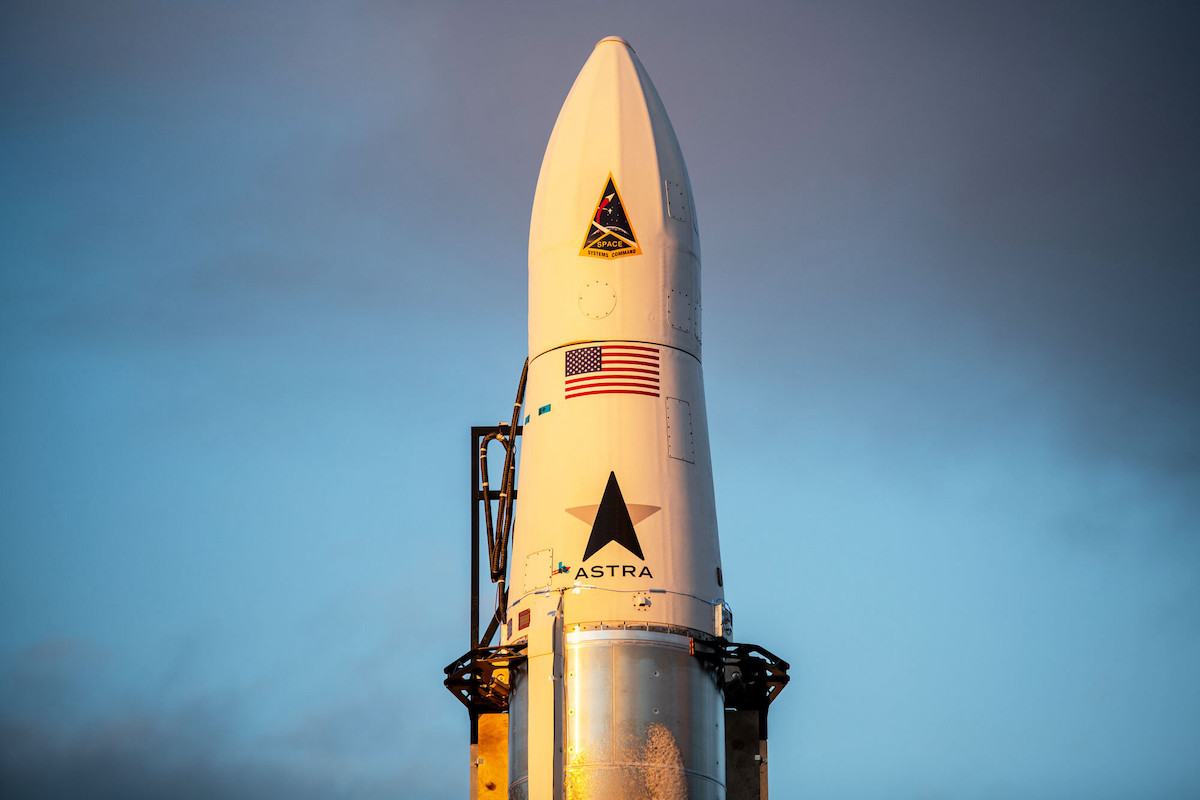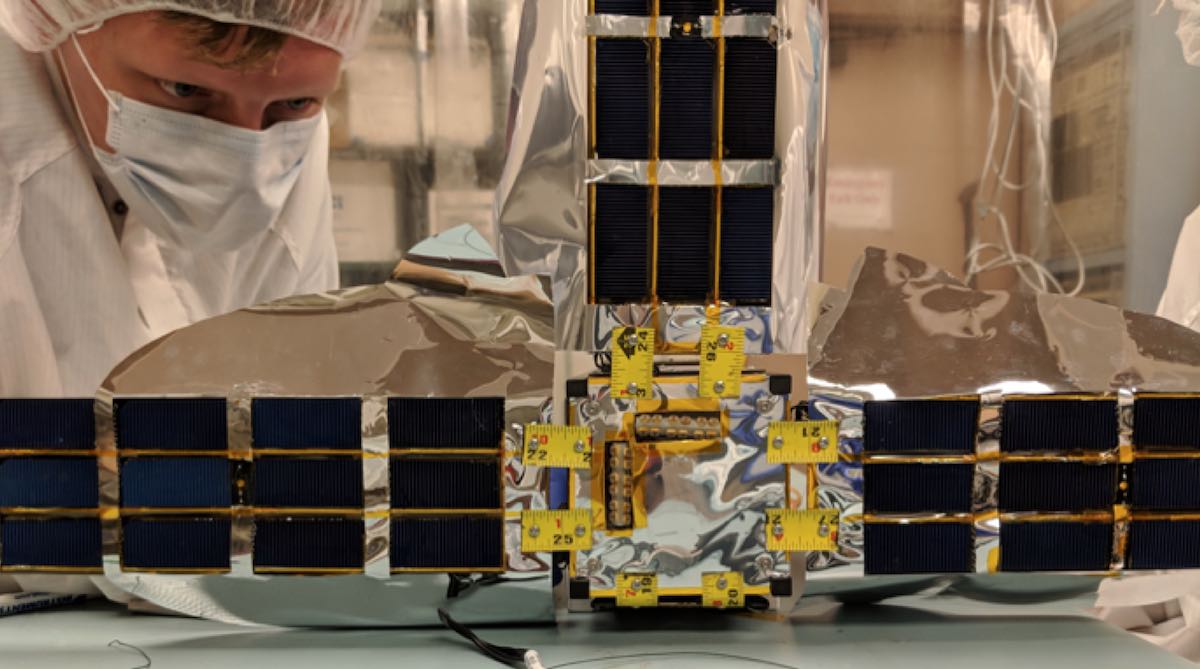
Tests are beginning this week at Cape Canaveral Space Force Station for the first flight of Astra’s small satellite launcher from the Florida spaceport, following the company’s successful November demonstration mission from Alaska.
Astra’s launch vehicle, dubbed Rocket 3.3 and known by its tail number LV0008, has shipped from the company’s headquarters and factory in Alameda, California, to Cape Canaveral for testing ahead of liftoff later this month.
Founded in 2016, the company aims to eventually conduct daily launches with small satellites, targeting a niche in the launch market cramped with competitors such as Rocket Lab, Virgin Orbit, and Firefly Aerospace, each of which has begun flying small launch vehicles. Numerous other companies are months or years away from debuting their smallsat launchers.
Astra’s rocket, in its current configuration, stands 43 feet (13.1 meters) tall and measures 4.3 feet (1.3 meters) wide. That’s somewhat narrower than — and about the same height as — the payload fairing on SpaceX’s Falcon 9 rocket.
As soon as this week, Astra plans a test-firing of the rocket’s five kerosene-fueled main engines at Space Launch Complex 46, a launch pad near the easternmost part of Cape Canaveral.
If everything goes as planned, the rocket could take off as soon as Tuesday, Jan. 18, with a launch window between 1 p.m. and 4 p.m. EST (1800-2100 GMT), according to multiple sources. But Astra hasn’t confirmed the launch schedule, only saying the mission is expected to lift off some time this month. Six CubeSats are set to ride the rocket into orbit on a mission sponsored by NASA, which has also been silent on the launch schedule.
The mission is part of NASA’s Venture Class Launch Services, or VCLS, program, which awarded Astra a $3.9 million contract last year for a commercial CubeSat launch. Scott Higginbotham, head of NASA’s CubeSat Launch Initiative at Kennedy Space Center, says the agency is the sole customer for the upcoming Astra launch.
The Venture Class Launch Services program is aimed at giving emerging small satellite launch companies some business, while helping NASA officials familiarize themselves with the nascent industry.
“NASA is going to be flying more and more small spacecraft going into the future because we can do mighty things in small packages now,” Higginbotham said in a recent interview. “So we need a stable of small launch vehicles that are right-sized to meet the needs of these small spacecraft because there will be times when we want to want to launch them on dedicated launches, versus always flying things rideshare on larger rockets.”
NASA previously awarded VCLS demonstration missions to Rocket Lab and Virgin Orbit, which completed their first launches for the U.S. space agency in 2018 and 2021. The U.S. military has awarded similar demonstration launch contracts to Astra and other companies.
Higginbotham said the VCLS mission gives NASA insight into companies’ management and technical teams, procedures and processes, and their hardware designs.
“That’s going to allow us to be a better consumer going forward if they stay in business, and can offer their services to us later on,” Higginbotham said. “We’ll already have been introduced and have done a deep dive, of sorts, into those companies to understand what makes them tick, and that’s that’s of tremendous value to us.”
The VCLS demo missions are also a stepping stone toward certification of the new smallsat launchers to carry more expensive NASA satellites into orbit. The certification isn’t required for the demo missions themselves.
“NASA has other missions that require a little bit more reliability from the launch vehicle, a little more certainty, and a little more launch vehicle insight,” Higginbotham said.
The upcoming mission from Florida follows Astra’s first successful launch into low Earth orbit on Nov. 20 from a launch site on Kodiak Island, Alaska. That mission was a test flight sponsored by the U.S. military.
The small stature of Astra’s rocket allows the company to transport the vehicle from the company’s headquarters in Alameda, California, in standard shipping containers. Astra also ships ground support infrastructure, such as a strongback tower and erector, to each launch site.
That allows Astra to set up a launch pad at austere locations, requiring only a flat concrete pad and electrical power. During launch the company’s previous campaigns in Alaska, Astra teams set up the launch pad and rocket in less than a week, with roughly a half-dozen on-site engineers and technicians.
The rest of the team remains behind at Astra’s launch control center in California. Internet connections allow controllers to monitor the rocket and payloads from thousands of miles away.
The architecture is part of Astra’s strategy to streamline rocket launch operations, using mass-produced boosters, engines, and a lean support team. The streamlined approach is coupled with Astra’s ability to build, test, and iterate, allowing the company to quickly introduce upgrades and changes.
With the successful flight in November, Astra reached orbit a little more than five years since its founding, beating the six-year mark from the establishment of SpaceX until its first orbital flight with the Falcon 1 rocket in 2008. Astra-built rockets faltered on three previous orbital launch attempts, and the company’s first orbit-capable launcher was destroyed during ground testing in Alaska in March 2020.

The satellites on-board Astra’s first launch from Cape Canaveral include two spacecraft on the CubeSat Radio Interferometry Experiment, or CURIE, mission.
The CURIE mission consists of two identical three-unit CubeSats, each the size of a shoebox, with radio antennas to detect emissions from solar activity, such was solar flares and coronal mass eruptions. Such activity send streams of charged particles through the solar system, affecting radio communications, satellite operations, electrical grids, and spawning colorful auroral displays at the poles.
The mission was developed by the University of California, Berkeley. In a feature story posted last year, the university said the CURIE mission cost about $3.2 million to develop, primarily with NASA funding. The cost figure does not include the price of the launch.
The CURIE satellites will be separated by one to two miles as they orbit Earth, adding a dimension to their tandem radio measurements to locate and track sources of radio emissions on the sun. It’s the first mission designed for radio interferometry in space, using techniques employed on larger scales with terrestrial radio telescope arrays, such as the Very Large Array in New Mexico.
Future space missions could use radio interferometry to study the sun or distant astronomical sources.
Astra’s rocket will launch a second CubeSat mission developed by the University of California, Berkeley. Named QubeSat, the small spacecraft will test a tiny gyroscope, a device used to help determine the orientation of satellites in space.
The gyroscope technology flying on the QubeSat mission is based on quantum mechanical interactions in imperfect diamonds, according to UC Berkeley. The gyroscope is created by blasting a synthetic diamond with nitrogen, which takes the place of some of the mineral’s carbon atoms, creating so-called “nitrogen-vacancy centers” that are very sensitive to magnetic fields.
Small spacecraft need miniature components, and the quantum gyroscope on the QubeSat mission can be sized to fit into a nanosatellite. Engineers will test the functionality of the quantum gyroscope over several months in orbit.
The entire QubeSat spacecraft weighs just 5.5 pounds (2.5 kilograms), according to NASA.
Another student-developed payload on Astra’s first launch from Florida is the Ionospheric Neutron Content Analyzer, or INCA mission, from New Mexico State University.
INCA’s main science instrument is a directional neutron spectrometer from NASA’s Goddard Space Flight Center.
Data from INCA will “contribute to understanding the radiation environment that satellites encounter, and to the understanding of neutron air showers, which pose a radiation hazard to occupants of high-altitude aircraft such as airliners,” according to the student team that developed the mission.
The BAMA 1 mission, developed at the University of Alabama, will demonstrate a drag sail device designed to help old satellites and space junk drop out of orbit. The drag sail will encounter air molecules from the rarefied atmosphere at the satellite’s altitude, slowing its velocity enough to fall back to Earth.
The final payload is a CubeSat named R5-S1 from NASA’s Johnson Space Center in Houston. NASA says the mission’s objectives including demonstrating quick CubeSat development and testing technologies useful for in-space inspection, which could make human spaceflight safer and more efficient.
“R5-S1 could prove a cheaper way to demonstrate crucial technologies like high-performance computers, cameras, algorithms and a new way for satellites to transmit pictures to the ground,” NASA said.
Email the author.
Follow Stephen Clark on Twitter: @StephenClark1.
